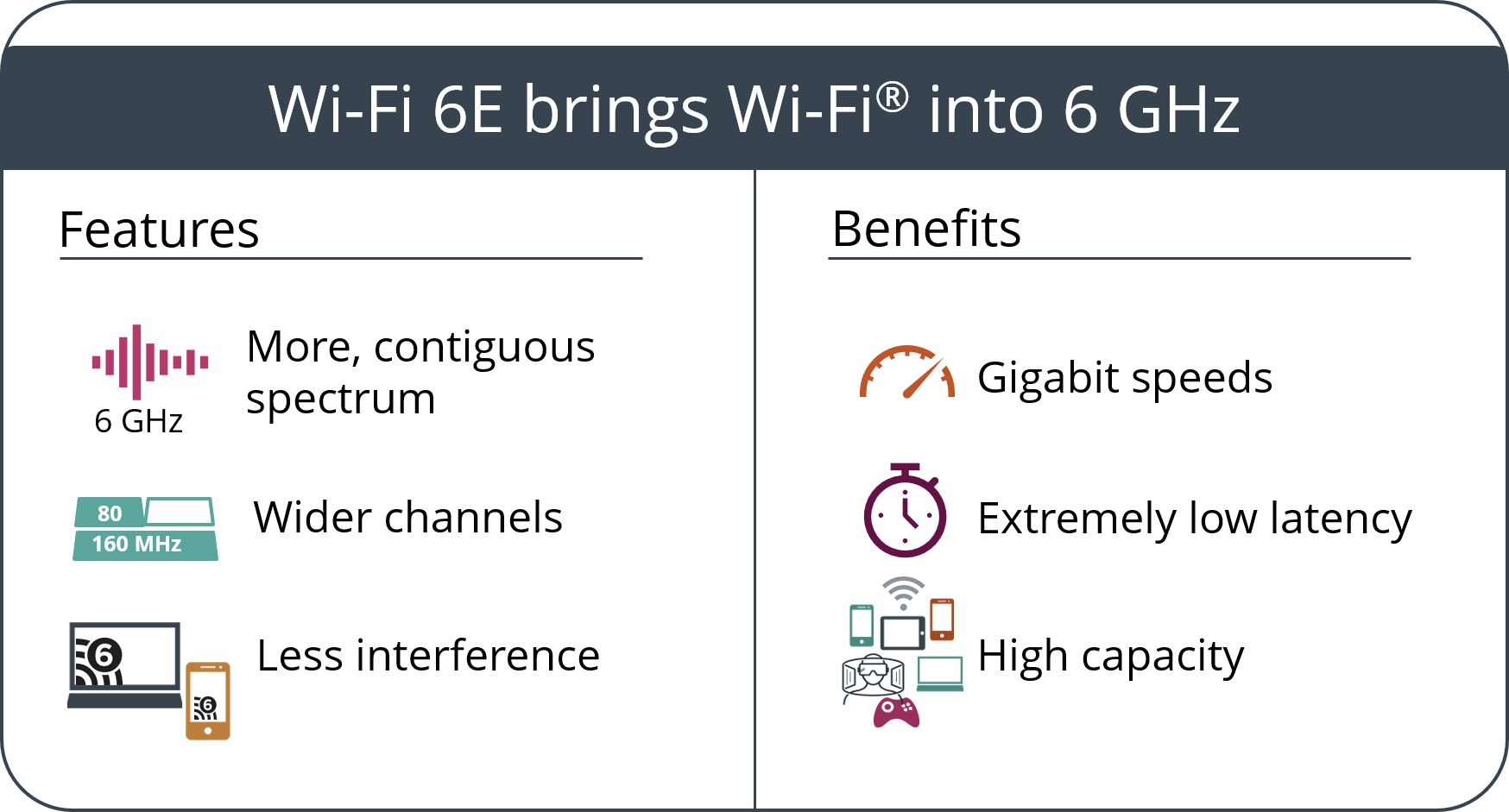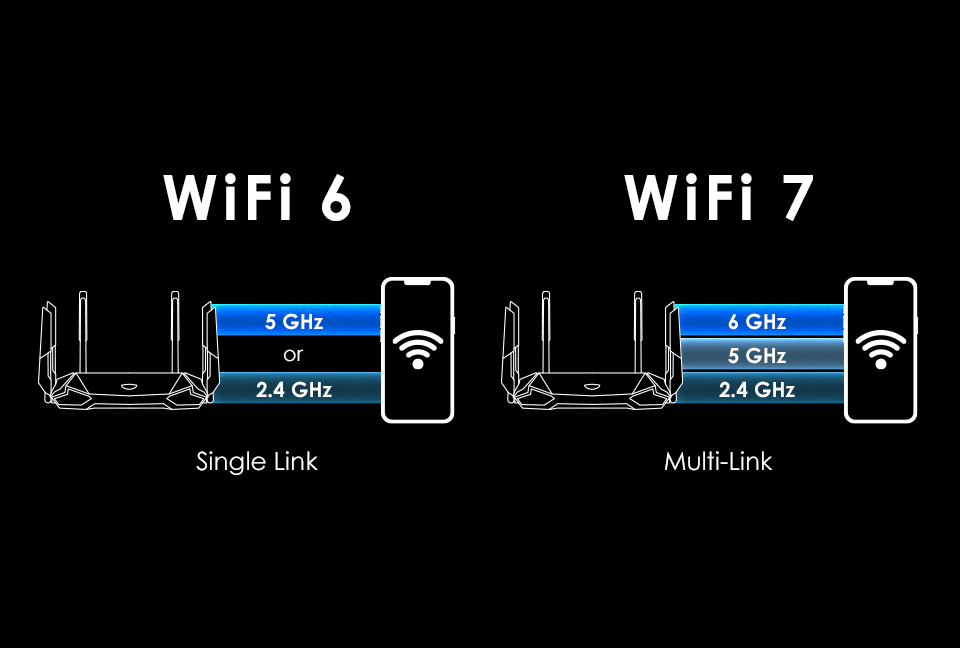Wi-Fi 6E vs Wi-Fi 7: What’s the difference?
In the ever-evolving landscape of wireless technology, the race to provide faster, more efficient, and more reliable connectivity is constantly accelerating. Two of the most recent and advanced wireless standards, Wi-Fi 6E and Wi-Fi 7, have emerged as promising contenders for the future of our digital connections. While both standards offer significant improvements over their predecessors, there are key distinctions that set them apart.
Wi-Fi 6E Overview : Expanding the Spectrum
Wi-Fi technology has really come a long way since it first hit the scene. With each new version released, it has certainly been impressive to see the advancements made with regards to speed, coverage, and reliability. The latest release, Wi-Fi 6E (extended implementation of 802.11ax) , has certainly made waves as it supports the 6GHz spectrum which easily eliminates the congestion that Wi-Fi 6 devices experienced. However, it seems we may already have something new to look forward to, as people are now talking about Wi-Fi 7, which supposedly offers even better capabilities.
Wi-Fi 6E Technical Explanation
Wi-Fi 6E is a newly introduced technology for Wi-Fi devices that operates on the 6 GHz frequency band. Unlike the existing 2.4 GHz and 5 GHz bands, WiFi6E provides significantly wider channel bandwidths for faster data transmission rates. The 6 GHz frequency band offers up to seven 160 MHz channels, which is three times wider than the maximum channel width available in the 5 GHz band, resulting in better network performance and reduced congestion.
Wi-Fi 6E has been designed to coexist with existing WiFi networks, devices, and technologies. Which ensures backward compatibility with other WiFi 6 devices while leveraging the newer 6 GHz frequency band.

Wi-Fi 6E: Expanding the Horizons of Wireless Connectivity-Credit: wi-fi.org
To benefit from Wi-Fi 6E, users will need to upgrade their devices and routers to support the technology. As a result, it is expected to become more widespread in the coming years, as more compatible products become available. With its significant improvements in network capacity and performance, WiFi6E promises to provide a better user experience for home and enterprise networks alike.
Wi-Fi 7 Overview : Pushing the Limits
Wi-Fi 7 is set to offer even better capabilities, supporting 2.4GHz, 5GHz, and 6GHz, providing even faster speeds than Wi-Fi 6E. Moreover, this technology comes with much more advanced features such as multiple channels in both uplink and down-link directions. It introduces 320MHz channel width, doubling the maximum of WiFi 6E, enabling data transfer speeds of up to 46 Gbps. Additionally, WiFi 7 utilizes a new frame format called Multi-Link Operation (MLO), which simultaneously utilizes multiple antennas to further boost performance.
Wi-Fi 7 Technical Explanation
Wi-Fi 7 is the next-generation of wireless connectivity that promises blazing-fast speeds, reliable connectivity, and reduced latency. This new technology is set to revolutionize the way we use the internet by providing faster and more reliable connectivity to users worldwide.
Wi-Fi 7 operates on the 6GHz band, which means it’s not hindered by congestion from other devices as it uses less congested channels. With speeds of up to 46Gbps, this technology will be the next step in our evolution to better, faster internet for all. This advancement will allow users to download and stream content at lightning-fast rates, making online gaming and 4K streaming smoother than ever before.
- WiFi 7 will also offer advanced features, such as multiple channels in both uplink and down-link directions, and finer frequency control for better quality of service.
- Other benefits of WiFi 7 include reduced latency, improved endpoint efficiency and better power consumption. This means that users will not have to worry about constant buffering, lagging, or disconnections, which will ultimately result in a more seamless online experience.

Wi-Fi 7: Unleashing the Power of Multi-Link Operation Credit: msi.com
Wi-Fi 6E vs Wi-Fi 7: Specifications
| Wi-Fi 6E | Wi-Fi 7 | |
| Data bands | 2.4, 5 and 6GHz | 2.4, 5 and 6GHz |
| Bandwidth (Channels) | 20, 40 , 80, 80+80, 160MHz | 20, 40 , 80, 80+80, 160, 320MHz |
| Max speed | 9.6 Gbps | 46 Gbps |
| Highest Modulation Order | 1024-QAM | 4096-QAM |
| Max Number of Spatial Streams | 8 | 16 |
When to Upgrade to Wi-Fi 7
Currently, Wi-Fi 7 devices are still in their early stages of development and availability. However, as the standard matures and more compatible devices enter the market, the transition to this technology will become more feasible. For those seeking the ultimate in wireless performance and are willing to invest in the latest technology, WiFi 7 will undoubtedly be the preferred choice. If you have a high-speed internet connection and client devices that support Wi-Fi 7, upgrading to a compliant router could significantly improve your internet experience.
Conclusion: Embracing the Next Frontier of Wireless Technology
The advancements brought about by Wi-Fi 6E and Wi-Fi 7 mark a pivotal moment in the evolution of wireless connectivity. With their significantly improved speeds, wider bandwidth, and enhanced efficiency, these standards are poised to revolutionize the way we connect and experience the digital world. As we embrace their transformative power, we can expect to see an era of seamless, high-performance connectivity that empowers us to work, play, and connect with the world in ways never before imagined.





